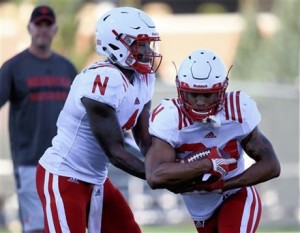
By ERIC OLSON
Quarterback runs were supposed to be de-emphasized in Nebraska’s new offense. At least that was Tommy Armstrong Jr.’s recollection of his first conversation with offensive coordinator Danny Langsdorf.
That was last winter, though. After practices in the spring and through two weeks of the preseason, Armstrong appears to have the green light to take off if he sees an opening.
It’s another sign coach Mike Riley isn’t going to force a full-scale change to the pro-style system. Elements of the old Nebraska spread/zone-read option offense will remain.
Armstrong last year ran for 705 yards on 145 carries, second-most on the team in both categories and second among Big Ten quarterbacks behind Ohio State’s J.T. Barrett. Langsdorf said Monday he never intended to totally change Armstrong’s style.
“We’ve always known he can run. You look at last year’s stuff, and he has some real strengths running the ball,” Langsdorf said. “What we don’t want to do is lose him to an injury because he’s getting hit all the time. I want him to run like crazy and get out of bounds or slide and save those hits. I think that’s important.”
Armstrong wasn’t shy about taking contact his first two years as the starter. His hurdling of a Northwestern defender near the goal line was one of his signature plays in 2014.
The 6-foot-1, 220-pound Armstrong made one of the best plays in a weekend scrimmage when he kept the ball on a zone-read keeper and ran 50 yards for a touchdown.
“We’re not going to turn him into a statue by any means,” Langsdorf said. “He’s going to move around, and we’re all for him making plays in the passing game and running the ball.”
The passing game needs work. Armstrong and the other quarterbacks struggled in practice with interceptions the last two weeks.
Armstrong was a 53-percent passer last year, and his ratio of one interception every 22.2 attempts in Big Ten games was second-worst in the conference. Langsdorf declined to disclose Armstrong’s completion percentage in preseason practices.
“Incompletions and interceptions, they can easily be pointed at the quarterback,” Langsdorf said. “But there are a ton of times where the ball was thrown correctly, the receiver was wrong, maybe it’s a tipped ball.”
Armstrong said not all the interceptions in practice have been the result of bad throws.
“When we have miscommunication and one person is on one page and the quarterback’s on another,” he said, “that’s how it happens.”
Langsdorf the passing game has improved with the return of seasoned receivers Jordan Westerkamp and De’Mornay Pierson-El from minor injuries.
“It’s players, not plays,” Langsdorf said. “When you get some of those guys who are your top guys playing, it makes it look better for sure.”
This week’s practices will be important for getting the offense to run smoother because next week marks the start of preparations for the Sept. 5 opener against BYU.
“We’re close,” Armstrong said. “Communication, that’s the one thing we have to focus on these next couple weeks. We have everything down pat where we need to be. Quarterback-wise, we have to be sharper when it comes to making reads. Overall, we’re in good shape. I think we can get better.”
